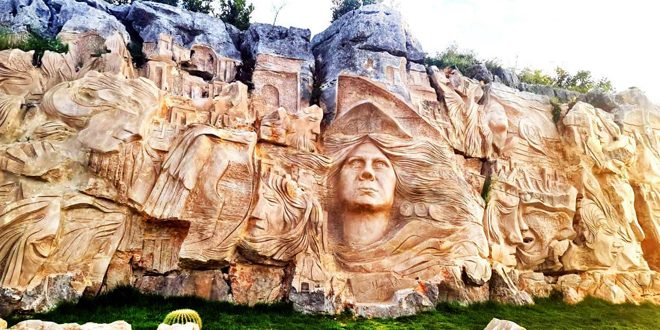Artist Alaa Ali Muhammad has managed to gain a prominent position among the Arab sculptors for his unique and outstanding talent, which is clearly reflected in all the exquisite sculptures and the amazing works he has done.
The two sculptural murals that embodied the nature and beauty of his village, as well as his academic art studies, have dedicated his allegiance to the sculpture world he so loves.
About his recent work, which he completed last May, Muhammad stated that it was a mural entitled “The Imprint of an Age.” It met with success and admiration, indicating that it is an epic work, its characters and symbols are inspired by the place in the Oyoun Al-Wadi area. He added that this work is the result of a joint vision with his friend Raymond Hajji, who accompanied him for 15 years in his work and the forums in which he participated in agreement with the supporting party.
Artist Muhammad points out that the presence of the mural on a central road linking Tartus to Homs and Hama and the rest of the interior regions makes it widely visible by people, to be the first Arab artist who performs two large sculptures on two large rock cliffs through which he revealed his secrets and feelings.
 Talking about the largest and first panoramic sculptural work in the Arab world, Muhammad said, “This work was done on a rocky shelf of the village of Bramant Al-Mashaikh in 2007. I agreed with the supporting party to create a panoramic work on that shelf, since the main character is the militant Khalil Al-Khatib, who with Sheikh Saleh Al-Ali confronted the French occupation, will be stationed in the center of the shelf. A group of sculptors was called in to help carry out the sculptural work.
Talking about the largest and first panoramic sculptural work in the Arab world, Muhammad said, “This work was done on a rocky shelf of the village of Bramant Al-Mashaikh in 2007. I agreed with the supporting party to create a panoramic work on that shelf, since the main character is the militant Khalil Al-Khatib, who with Sheikh Saleh Al-Ali confronted the French occupation, will be stationed in the center of the shelf. A group of sculptors was called in to help carry out the sculptural work.
The artist’s choice of sculpture was the result of his daily observations and his contact with the various bodies of stones and materials in his area. His village, Khirbat Takla, in the area of Sheikh Badr, is characterized by its mountainous nature, which brings together the beauty of nature and the harsh rock. His study in the sculpture department of the College of Fine Arts was therefore the most prominent step in shaping his artistic identity and entering into the worlds he had always been passionate about.
During his studies, Muhammad was briefed on the works of the most important sculptors from inside Syria and abroad, particularly the Russian Art School.
 Muhammad emphasized the important positive role played by his teachers, especially the sculptor Fayez Nahri, his teacher, who followed the school of realism.. He adopted realism at a time when many artists resorted to modernity, so realism and expressionism gained the greatest space for his production. He has many works representing these two schools, as well as carving works belonging to symbolism.
Muhammad emphasized the important positive role played by his teachers, especially the sculptor Fayez Nahri, his teacher, who followed the school of realism.. He adopted realism at a time when many artists resorted to modernity, so realism and expressionism gained the greatest space for his production. He has many works representing these two schools, as well as carving works belonging to symbolism.
Regarding the “Birth from a Tree Branch” sculpture that he carried out in Mashta El Helou, he suggested that this work was the beginning of the 2013 Family Cultural Meeting in Mashta El Helou
He carved part of a branch that fell out of a tree , forming a woman raising her left hand up and holding a leaf, while the right hand points towards the ground in a sign of clinging to it. A young branch grew on the woman’s body to announce the birth of the tree again in a metaphorical image for the emergence of a new Syria.
To learn more about the idea of creating the Tartus sculpture forum, which was proposed by the sculptor Muhammad, he explained that this idea, which was supported by the officials and concerned authorities in the governorate, was based on organizing a permanent work site for every Syrian sculptor. The forum was supposed to be equipped with all needed supplies, including roads, electricity, water, warehouses, and machinery. It was called “Tartous, The Mother of the Martyrs” and its first session was launched in 2015 with the participation of more than 30 sculptors.
Amal Farhat

